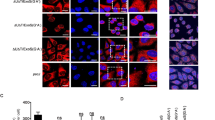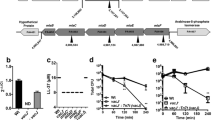Abstract
Over 100 of Pseudomonas aeruginosa isolates representing the two TTSS genotypes (exoU −/exoS + or exoU +/exoS −) were cultured in different media in order to evaluate their proteolytic activities and find a relationship between proteolytic activity and the cytotoxic and/or invasive phenotypes displayed by the strains upon infection of RAW 264.7 murine macrophage-like cells and pulmonary microvascular endothelial cells (PME). The elastolytic activity, protein concentration, and total proteolytic activity (TPA) were measured in culture supernatants. No significant differences were observed in the median elastolytic activities among cytotoxic/noninvasive, noncytotoxic/invasive, and cytotoxic/invasive phenotypes displayed by P. aeruginosa strains. The only significant difference was noted when isolates of the two different TTSS genotypes were grown in a calcium-depleted minimal medium for induction of TTSS (MI). The exoU −/exoS + isolates showed significant higher levels of the median elastolytic activity when compared to the exoU +/exoS − isolates. These two groups of isolates secreted the elastase B (LasB) with distinct molecular masses 158 or 116 kD, respectively. The strains of the two TTSS genotypes secreted similar amount of total proteins; however, the higher values of TPA were observed for the isolates of the exoU + /exoS − genotype when grown in MI medium. We concluded that there is no direct relationship between secretion of proteases with elastolytic activity and the cytotoxic and/or invasive phenotypes of the isolates observed upon infection of both RAW 264.7 and PME monolayers. Further studies are needed to find out whether others factors beside proteases could influence the mechanism of host cells intoxication mediated by the P. aeruginosa TTSS-delivered toxins.

Similar content being viewed by others
References
Atlas RM (1997) Handbook of microbiological media, 2nd edn. CRC Press Inc, Boca Raton, FL
Choy MH, Stapelton F, Wilcox MDP, Zhu H (2008) Comparison of virulence factors in Pseudomonas aeruginosa strains isolated from contact lens- and non-contact lens-related keratitis. J Med Microbiol 57:1539–1546
Cowell BA, Twining SS, Hobden JA, Kwong MS, Fleiszig SM (2003) Mutation of lasA and lasB reduces Pseudomonas aeruginosa invasion of epithelial cells. Microbiol 149:2291–2299
Driscoll JA, Brody SL, Kollew MH (2007) The epidemiology, pathogenesis and treatment of Pseudomonas aeruginosa infections. Drugs 67:351–368
Engel J, Balachandran P (2009) Role of Pseudomonas aeruginosa type III effectors in disease. Curr Opin Microbiol 12:61–66
El Solh AA, Akinnusi ME, Wiener-Kronish JP, Lynch SV, Pineda LA, Szarpa K (2008) Persistent infection with Pseudomonas aeruginosa in ventilator-associated pneumonia. Am J Respir Crit Care Med 178:513–519
Kida Y, Higashimoto Y, Inoue H, Shimizu T, Kuwano K (2008) A novel secreted protease from Pseudomonas aeruginosa activates NF-kappaB through protease-activated receptors. Cell Microbiol 10:1491–1504
Kim J, Ahn K, Min S, Jia J, Ha U, Wu D, Jin S (2005) Factors triggering type III secretion in Pseudomonas aeruginosa. Microbiology 151:3575–3587
Lomholt JA, Poulsen K, Kilian M (2001) Epidemic population structure of Pseudomonas aeruginosa: evidence for a clone that is pathogenic to the eye and that has a distinct combination of virulence factors. Infect Immun 69:6284–6295
Nicas TI, Gilewski BH (1984) Isolation and characterization of transposon-induced mutants of Pseudomonas aeruginosa deficient in production of exoenzyme S. Infect Immun 45:470–474
Nouwens AS, Willcox MD, Walsh BJ, Cordwell SJ (2002) Proteomic comparison of membrane and extracellular proteins from invasive (PAO1) and cytotoxic (6206) strains of Pseudomonas aeruginosa. Proteomics 2:1325–1346
Ołdak E, Trafny EA (2005) Secretion of proteases by Pseudomonas aeruginosa biofilms exposed to ciprofloxacin. Antimicrob Agents Chemother 49:3281–3288
Saliba AM, de Assis MC, Nishi R (2006) Implications of oxidative stress in the cytotoxicity of Pseudomonas aeruginosa ExoU. Microbes Infect 8:450–459
Schmidtchen A, Wolff H, Hansson C (2001) Differential proteinase expression by Pseudomonas aeruginosa derived from chronic leg ulcers. Acta Derm Venereol 81:406–409
Stępińska MA, Trafny EA (2008) Diverse type III secretion phenotypes among Pseudomonas aeruginosa strains upon infection of murine macrophage-like and endothelial cell lines. Microbiol Pathog 44:448–458
Tang A, Marquart ME, Fratkin JD, McCormick CC, Caballero AR, Gatlin HP, O’Callaghan RJ (2009) Properties of PASP: a Pseudomonas protease capable of mediating corneal erosions. Invest. Ophthalmol Vis Sci 50:3794–3801
Tingpej P, Smith L, Rose B, Zhu H, Conibear T, Al Nassafi K, Manos J, Elkins M, Bye P, Willcox M, Bell S, Wainwright C, Harbour C (2007) Phenotypic characterization of clonal and nonclonal Pseudomonas aeruginosa strains isolated from lungs of adults with cystic fibrosis. J Clin Microbiol 45:1697–1704
Thibodeaux BA, Caballero AR, Marquart ME, Tommassen J, O’Callaghan RJ (2007) Corneal virulence of Pseudomonas aeruginosa elastase B and alkaline protease produced by Pseudomonas putida. Curr Eye Res 32:373–386
Zhang J, Takayama H, Matsuba T, Jiang R, Tanaka Y (2003) Induction of apoptosis in macrophage cell line, J774, by the cell-free supernatant from Pseudomonas aeruginosa. Microbiol Immunol 47:199–206
Zhu H, Thuruthyil SJ, Willcox MDP (2000) Invasive strains of Pseudomonas aeruginosa are able to cause epithelial cell cytotoxicity that is dependent on bacterial cell density. Clin Experiment Ophtalmol 28:201–204
Zhu H, Thuruthyil SJ, Willcox MDP (2002) Determination of quorum-sensing signal molecules and virulence factors of Pseudomonas aeruginosa isolated from contact lens-inducted microbial keratitis. J Med Microbiol 51:1063–1070
Zhu H, Conibear TC, Bandara R, Aliwarga Y, Stapleton F, Willcox MD (2006) Type III secretion system-associated toxins, proteases, serotypes, and antibiotic resistance of Pseudomonas aeruginosa isolates associated with keratitis. Curr Eye Res 31:297–306
Author information
Authors and Affiliations
Corresponding author
Rights and permissions
About this article
Cite this article
Stępińska, M.A., Ołdak, E. & Trafny, E.A. Proteolytic Activity of Pseudomonas aeruginosa Isolates with TTSS-Mediated Cytotoxicity and Invasiveness to Host Cells. Curr Microbiol 60, 360–364 (2010). https://doi.org/10.1007/s00284-009-9550-4
Received:
Accepted:
Published:
Issue Date:
DOI: https://doi.org/10.1007/s00284-009-9550-4




